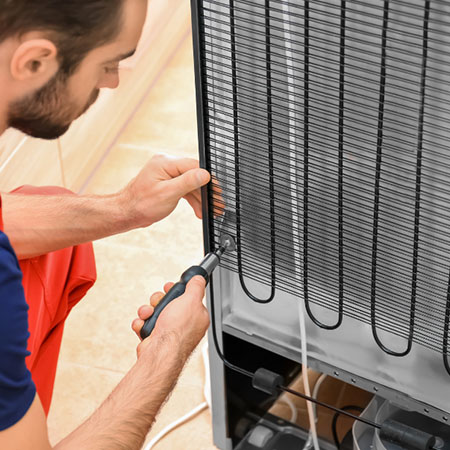Why Is My Concord Refrigerator Not Cooling?
Common Causes, What to Check, and When to Call a Local Repair Expert
Warm Fridge? You’re in the Right Place.
A refrigerator that’s not keeping your food cold is more than just an inconvenience—it’s a problem that can lead to food spoilage, waste, and stress. At Concord Appliance Repair, we’ve connected helped countless homeowners to professional appliance repair technicians to troubleshoot and repair refrigerators that just won’t stay cool. Whether it’s a simple fix or a deeper issue, we’re here to help.

Thermostat or Temperature Control Setting
First things first—check the thermostat. It’s easy for someone to accidentally bump the temperature setting while loading groceries. Make sure your fridge is set between 37°F and 40°F, and the freezer at 0°F.
Tip: Wait 24 hours after adjusting the thermostat to see if the temperature normalizes before assuming a mechanical problem.
Dirty or Clogged Condenser Coils
Dust and debris can build up on the condenser coils (usually located behind or beneath the fridge), preventing the unit from dissipating heat effectively. When the coils are clogged, your refrigerator works harder to stay cool—and may stop cooling entirely.
Fix: Unplug the unit and clean the coils with a vacuum or coil cleaning brush every 6–12 months.
Faulty Evaporator Fan Motor
The evaporator fan circulates cold air throughout the fridge and freezer compartments. If it fails, your freezer may still be cold while your fridge is warm—or the whole unit may feel undercooled.
Sign: You may hear the fridge running but not feel air moving inside the fridge section.
Broken Start Relay or Compressor Issue
The start relay helps your compressor kick on. If it’s defective, the compressor may not start at all—leading to a complete lack of cooling. If the compressor itself has failed, this is a major issue and often requires professional repair or replacement.
Note: A clicking sound every few minutes is often a sign the relay is trying—and failing—to start the compressor.
Blocked Air Vents or Overloaded Shelves
Cold air needs room to circulate. If you’ve packed the fridge too tightly or accidentally blocked the air vents with food containers, airflow can be restricted and cause uneven temperatures.
Solution: Reorganize your fridge and leave space around vents for proper air distribution.
Door Seal (Gasket) Is Damaged
If your refrigerator door gasket is cracked, loose, or dirty, warm air can seep in and cold air can escape. This causes your unit to work harder—and may stop it from maintaining the correct temperature.
Test: Close the door on a dollar bill and see if you can easily pull it out. If so, your seal may need replacing.
Control Board or Thermistor Failure
More advanced refrigerators rely on control boards and sensors (thermistors) to manage cooling cycles. If one of these components fails, your fridge might stop cooling even though the lights and fans still run.
When to call a pro: These components require professional tools to diagnose properly and should only be replaced by a trained technician.
What to Do If Your Fridge Is Still Warm
If none of these steps resolve the issue, it’s time to bring in a technician.
Call Concord Appliance Repair for Fast Fridge Repair
We work with skilled local technicians who can diagnose refrigerator cooling issues quickly and provide reliable solutions. From compressor problems to failed sensors, we’ve got the “tools” and expertise to get your fridge back to proper temps fast.
